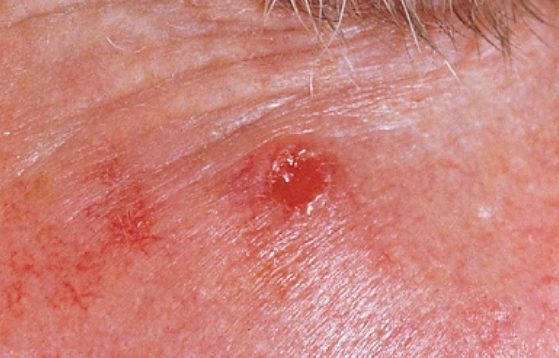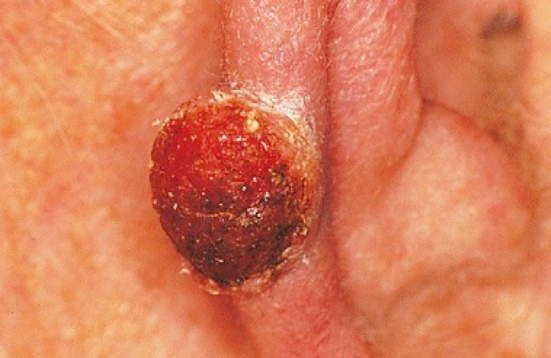Skin Cancer
Content of This Page
1- Introduction
2- Causes
3- Symptoms
4- Types of Disease
5- Treatment
6- What Should You Avoid
Introduction
Skin cancer is the abnormal growth of skin cells, typically resulting from DNA damage caused by ultraviolet (UV) radiation from the sun or tanning beds. It is one of the most common forms of cancer and can develop anywhere on the body, but it most often occurs in areas exposed to the sun, such as the face, neck, hands, and arms.

Causes
1. Ultraviolet (UV) Radiation
- Sun Exposure: The most common cause of skin cancer is prolonged and unprotected exposure to ultraviolet (UV) rays from the sun. UV radiation damages the DNA in skin cells, leading to mutations that can cause cells to grow uncontrollably.
- Tanning Beds: Artificial sources of UV radiation, such as tanning beds and sunlamps, also significantly increase the risk of skin cancer, especially in younger people.
2. Genetic Factors
- Family History: Individuals with a family history of skin cancer, especially melanoma, are at a higher risk of developing the disease due to inherited genetic mutations.
- Fair Skin, Light Hair, and Light Eyes: People with fair skin that burns easily, light-colored hair, and light eyes are more susceptible to UV damage and, therefore, skin cancer.
3. Moles and Atypical Moles
- Multiple Moles: Having a large number of moles (more than 50) increases the risk of melanoma.
- Atypical Moles (Dysplastic Nevi): These are unusual moles that may look similar to melanoma. People with atypical moles are at a higher risk of developing melanoma.
4. Weakened Immune System
- Immunosuppression: Individuals with weakened immune systems, such as those who have had organ transplants and are on immunosuppressive drugs, or those with conditions like HIV/AIDS, are at a higher risk of skin cancer. The immune system plays a crucial role in detecting and destroying cancerous cells, so when it’s compromised, the risk of cancer increases.
5. Age
- Advancing Age: The risk of developing skin cancer increases with age, as the cumulative effects of sun exposure over time contribute to skin damage and cancer development.
6. Exposure to Certain Chemicals
- Carcinogenic Chemicals: Prolonged exposure to certain chemicals, such as arsenic, tar, and some industrial compounds, can increase the risk of developing skin cancer, particularly squamous cell carcinoma.
7. Radiation Exposure
- Previous Radiation Therapy: People who have received radiation treatment for other conditions, particularly at a young age, have an increased risk of developing skin cancer in the treated area later in life.
8. History of Sunburns
- Severe Sunburns: Having one or more blistering sunburns, particularly during childhood or adolescence, significantly increases the risk of melanoma later in life. Each sunburn increases the cumulative damage to the skin.
9. Certain Medical Conditions
- Xeroderma Pigmentosum: This rare genetic disorder affects the skin’s ability to repair DNA damage caused by UV light, leading to a very high risk of skin cancer.
10. Skin Type and Ethnicity
- Skin Type: Fair-skinned individuals, particularly those with freckles, are more prone to skin cancer because they have less melanin, which provides some protection against UV radiation.
- Ethnicity: While skin cancer is less common in people with darker skin, it can still occur and is often diagnosed at a more advanced stage in these populations. This is partly due to the misconception that darker skin is not at risk, leading to delayed diagnosis and treatment.
11. Chronic Inflammation or Injury
- Chronic Wounds or Inflammation: Areas of the skin that have been chronically inflamed, scarred, or injured may have an increased risk of developing squamous cell carcinoma.
12. Certain Medications
- Photosensitizing Drugs: Some medications, such as certain antibiotics, nonsteroidal anti-inflammatory drugs (NSAIDs), and diuretics, can make the skin more sensitive to UV radiation, increasing the risk of sunburn and skin cancer.
Symptoms
- Changes in Skin: Any new growth or a sore that doesn’t heal can be a sign of skin cancer.
- ABCDE Rule for Melanoma:
- Asymmetry: One half of the mole or spot doesn’t match the other.
- Border: The edges are irregular, ragged, or blurred.
- Color: The color is not uniform and may include shades of brown, black, or even red, white, or blue.
- Diameter: The spot is larger than 6mm across (about the size of a pencil eraser), although melanomas can be smaller.
- Evolving: The mole or spot is changing in size, shape, or color.

Types of Disease
Basal Cell Carcinoma (BCC)
- Description: The most common and least aggressive form of skin cancer. It arises from the basal cells in the lowest layer of the epidermis.
- Appearance: BCC often appears as a pearly or waxy bump, flat, flesh-colored or brown scar-like lesion, or a sore that bleeds, crusts, and doesn’t heal.
- Growth: BCC grows slowly and rarely spreads (metastasizes) to other parts of the body but can cause significant local damage if untreated.
Squamous Cell Carcinoma (SCC)
- Description: The second most common type of skin cancer, arising from the squamous cells in the outer layer of the skin.
- Appearance: SCC may appear as a firm, red nodule, a flat lesion with a scaly crust, or a sore that bleeds or develops a crust.
- Growth: SCC can grow more aggressively than BCC and has a higher risk of spreading to other parts of the body, particularly if left untreated.
Melanoma
- Description: The most dangerous form of skin cancer, originating in the melanocytes, which produce the pigment melanin.
- Appearance: Melanoma can develop in an existing mole or as a new dark spot on the skin. It often appears as a large brownish spot with darker speckles, a mole that changes in color, size, or feel, or a lesion with irregular borders and multiple colors.
- Growth: Melanoma can spread rapidly to other parts of the body (metastasize) and is more likely to be fatal if not detected early.
Less Common Types
- Merkel Cell Carcinoma: A rare but aggressive form of skin cancer that appears as a firm, red or purple nodule, often on the face, head, or neck.
- Kaposi Sarcoma: Often associated with weakened immune systems, it appears as red or purple patches on the skin or mucous membranes.
Treatment
- Surgical Removal: The most common treatment for skin cancer, involving the removal of the cancerous tissue along with some surrounding healthy tissue.
- Mohs Surgery: A precise surgical technique used for BCC and SCC, especially on the face. The surgeon removes the cancer layer by layer, examining each layer under a microscope until no abnormal cells remain.
- Radiation Therapy: Used when surgery isn’t an option or as an adjunct to surgery.
- Chemotherapy: Typically used for advanced cases, particularly melanoma that has spread to other parts of the body.
- Immunotherapy: A treatment that helps the immune system fight cancer, often used for advanced melanoma.
- Targeted Therapy: Drugs that target specific genetic mutations in cancer cells, used for advanced melanoma.
What Should You Avoid
1. Excessive Sun Exposure
- Impact: Prolonged or intense exposure to ultraviolet (UV) rays from the sun increases the risk of skin cancer, including melanoma.
- Avoid: Direct sunlight during peak hours (10 a.m. to 4 p.m.), and seek shade when outdoors. Limit your time in the sun, especially without protection.
2. Tanning Beds and Sunlamps
- Impact: Artificial UV radiation from tanning beds and sunlamps significantly raises the risk of skin cancer, particularly in younger people.
- Avoid: Using tanning beds and sunlamps. Opt for safer alternatives like self-tanning products if you want a tan.
3. Unprotected Skin Exposure
- Impact: Not using sunscreen or protective clothing can increase your risk of skin damage and skin cancer.
- Avoid: Going outside without applying broad-spectrum sunscreen with an SPF of 30 or higher. Also, avoid wearing inadequate clothing that doesn’t provide UV protection.
4. Ignoring Skin Changes
- Impact: Skin cancer, especially melanoma, can be more treatable if detected early. Ignoring suspicious changes can lead to delayed diagnosis and treatment.
- Avoid: Disregarding new or changing moles, spots, or any unusual skin changes. Regularly check your skin and consult a dermatologist if you notice any concerning changes.
5. Delaying Treatment
- Impact: Delayed treatment can allow skin cancer to grow or spread, leading to more severe health issues.
- Avoid: Postponing medical evaluation if you suspect skin cancer. Follow your healthcare provider’s recommendations and complete any prescribed treatments.
6. Exposure to Carcinogenic Chemicals
- Impact: Certain chemicals and substances can increase the risk of skin cancer.
- Avoid: Prolonged exposure to known carcinogens such as arsenic, tar, or industrial chemicals without appropriate protective measures.
7. Chronic Sunburns
- Impact: Severe sunburns, especially during childhood, increase the risk of developing skin cancer later in life.
- Avoid: Getting sunburned. If you do get sunburned, treat the skin gently and seek medical advice if the burn is severe.
8. Unprotected Environmental Exposure
- Impact: Extreme environmental conditions can exacerbate skin damage.
- Avoid: Extended exposure to harsh weather conditions, such as extreme cold or heat, without proper skin protection.
9. Photosensitizing Drugs
- Impact: Some medications can increase your sensitivity to UV radiation, raising the risk of skin damage and skin cancer.
- Avoid: Taking photosensitizing medications without proper sun protection. Discuss any concerns about medications with your healthcare provider.
10. Using Outdated or Ineffective Sunscreen
- Impact: Sunscreens that are past their expiration date or are not broad-spectrum may not provide adequate protection against UV radiation.
- Avoid: Using expired or ineffective sunscreens. Ensure your sunscreen is broad-spectrum and has an SPF of at least 30. Reapply regularly and after swimming or sweating.
11. Ignoring Skin Care After Treatment
- Impact: Post-treatment care is crucial for healing and reducing the risk of recurrence.
- Avoid: Neglecting skin care recommendations from your healthcare provider after skin cancer treatment. Follow post-treatment guidelines to support skin recovery.
12. Using Harsh Skin Products
- Impact: Certain skincare products can irritate or damage the skin, potentially increasing the risk of complications or interfering with healing.
- Avoid: Using products with harsh chemicals or fragrances on treated or sensitive skin. Opt for gentle, fragrance-free products.